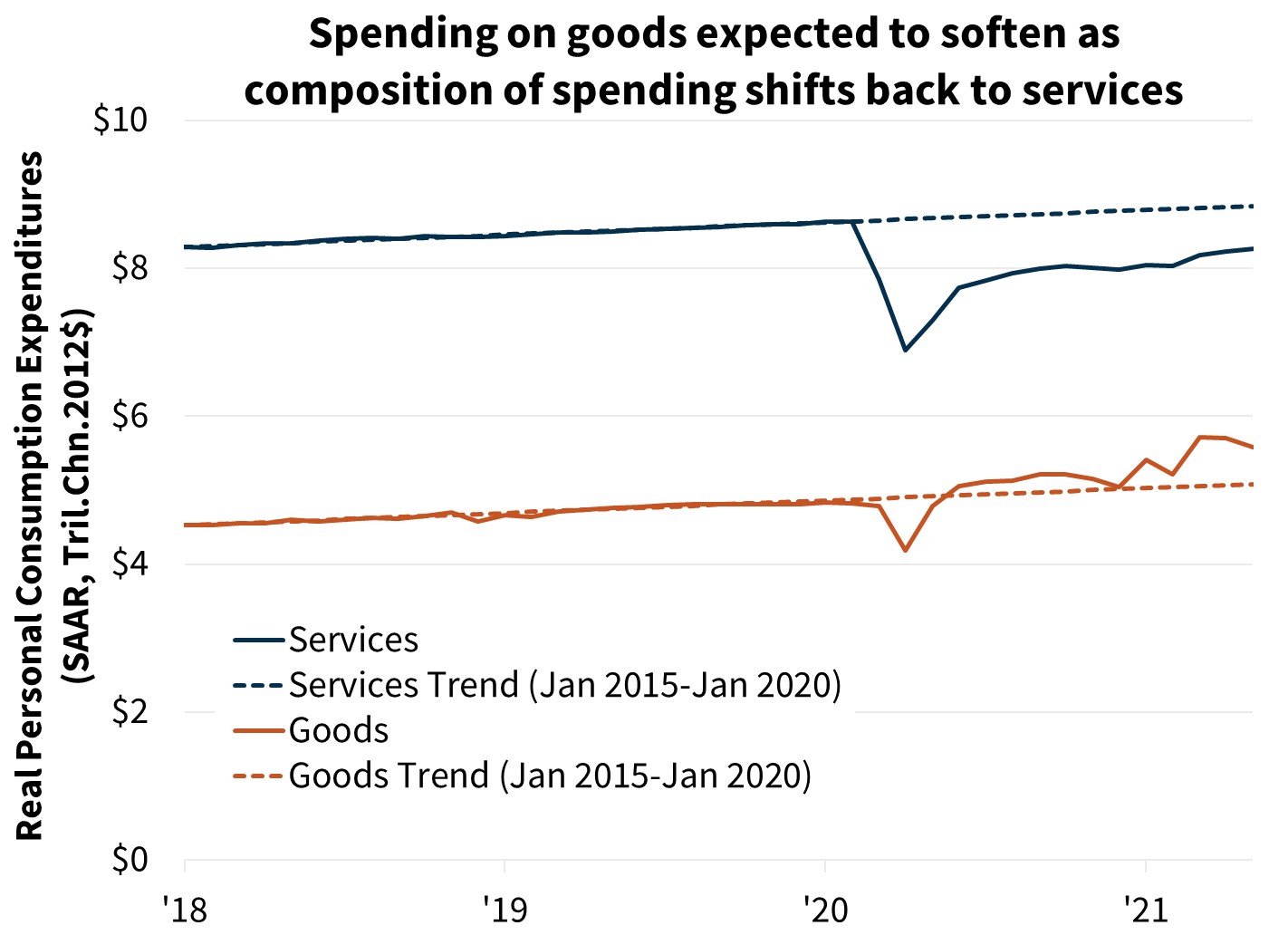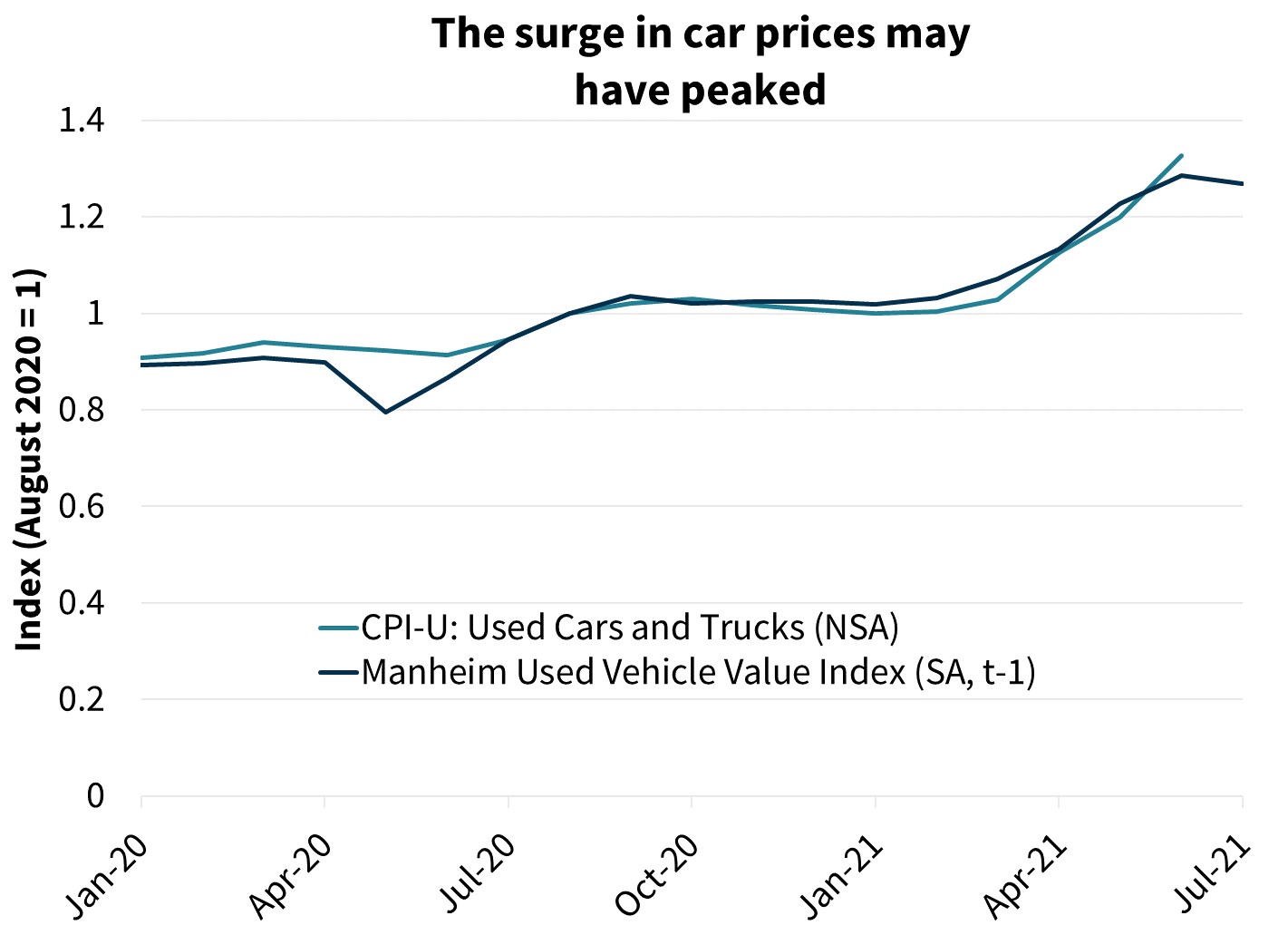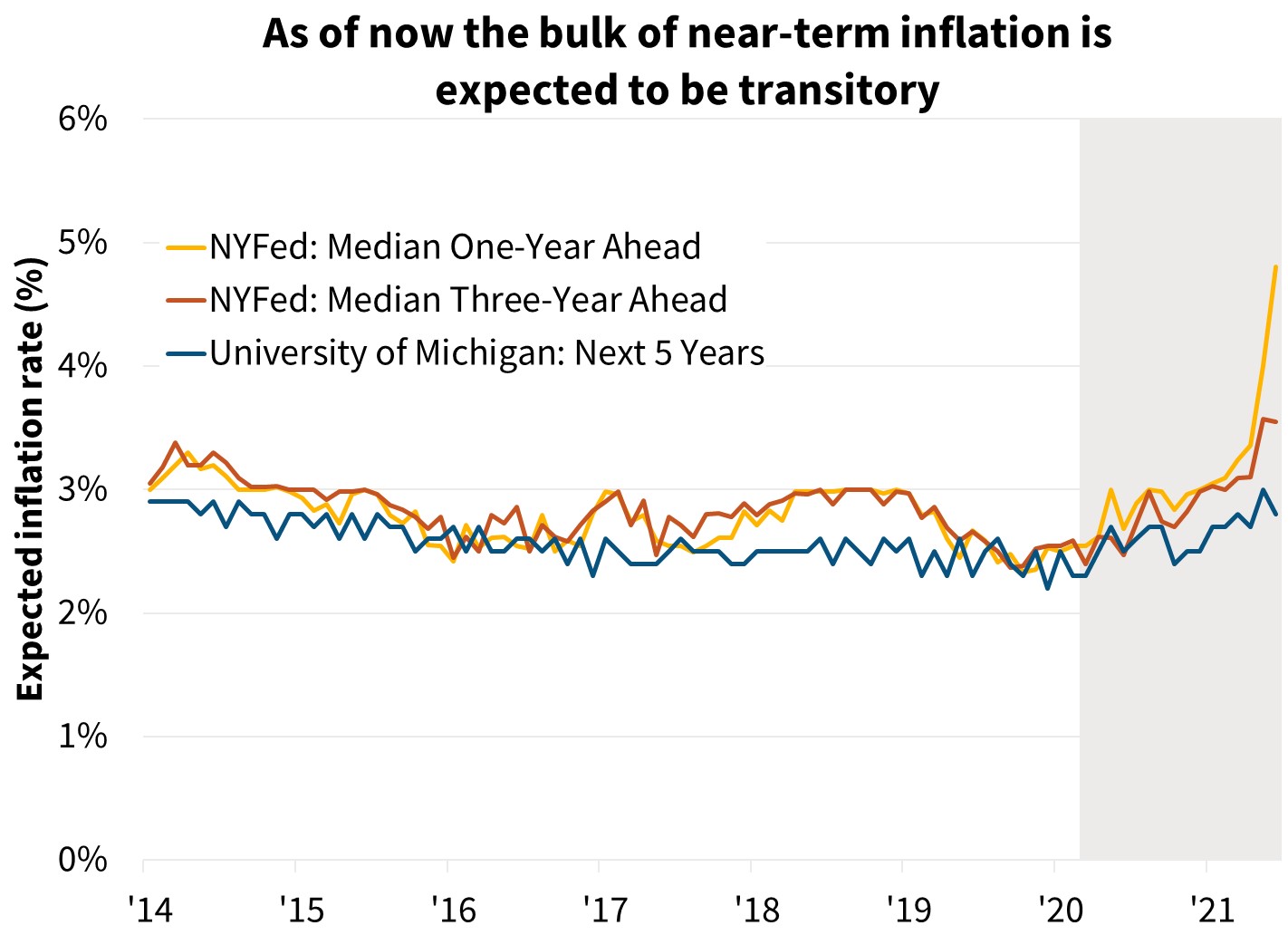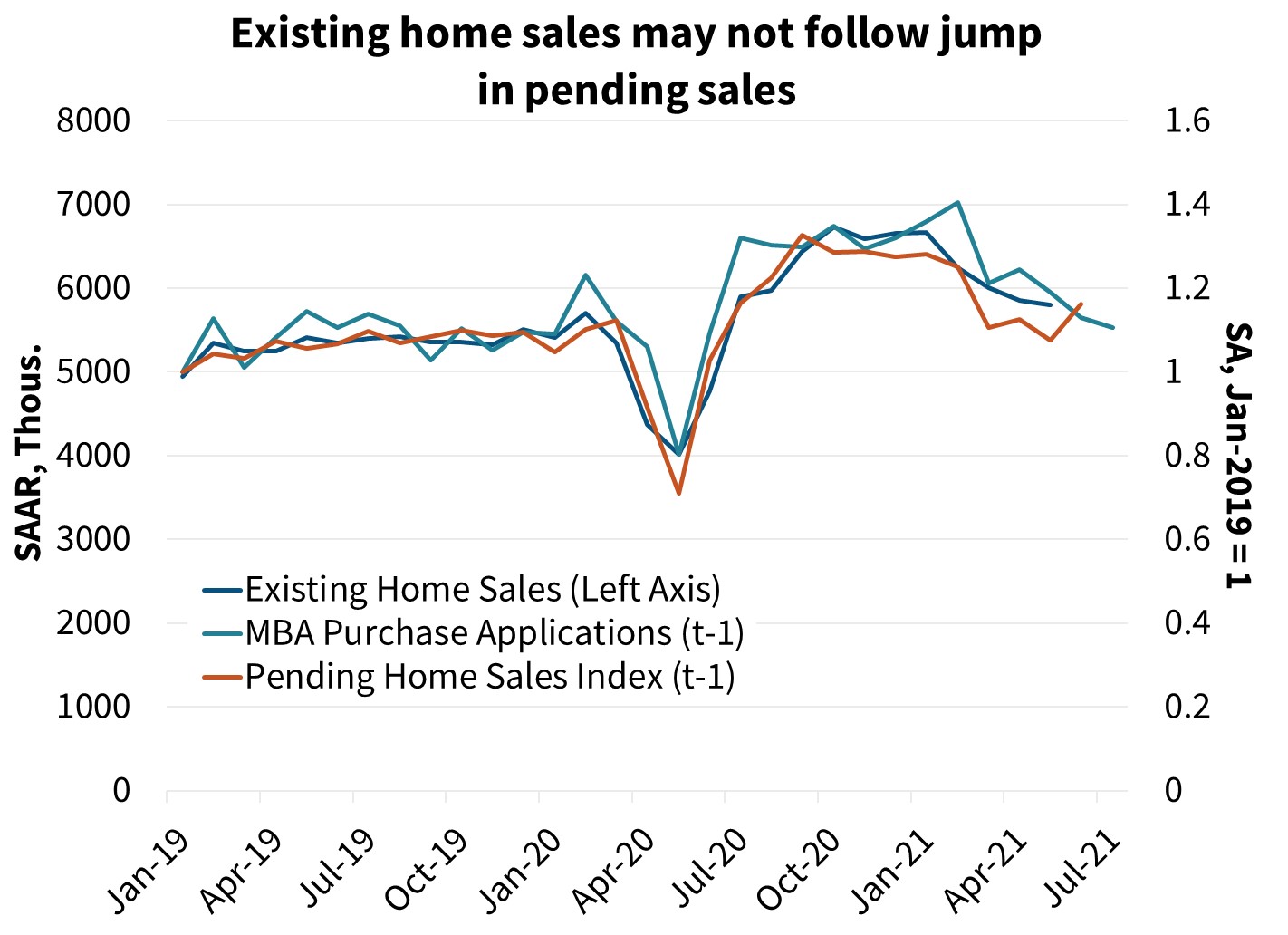Economy in Transition as Inflationary Concerns Mount
Our forecast for 2021 real gross domestic product (GDP) was revised downward one-tenth to 7.0 percent on a fourth quarter-over-fourth quarter (Q4/Q4) basis, with an offsetting uptick in 2022’s expected growth rate to 2.8 percent. However, the topline numbers mask more meaningful changes in our forecast of the time and sources of growth. Modestly weaker than anticipated incoming data on consumer spending and housing construction, along with updated federal spending projections from the Congressional Budget Office (CBO), led us to shift our forecast such that a larger share of 2021 growth is now expected to occur in the second half of the year. On a quarterly basis, we revised downward our second quarter GDP expectation to 8.1 percent annualized (from 10.1 percent last month) while revising upward the Q3 and Q4 outlooks. We forecast a significant deceleration in consumer spending moving forward, with GDP growth increasingly driven by inventory restocking and a shift toward spending on services rather than on goods. While we adjusted the path of our inflation forecast, we continue to expect broader inflationary pressures to partially offset many of the transitory factors currently driving heightened inflation readings. On an annual basis, we forecast the Consumer Price Index (CPI) to remain around 5 percent at the end of 2021. While substantial deceleration in inflation is expected to follow, inflation is expected to remain elevated through the end of 2022, with the CPI expected to end the year near 3 percent.
COVID Developments Add to Supply Chain Disruption and Inflation Risks
COVID-19 case growth, much of which is attributed to the Delta variant of the coronavirus, adds additional risk to our outlook. While restricted economic activity is a risk moving forward, currently, countries with comparatively high vaccination rates have not experienced meaningful increases in hospitalizations or fatalities even as cases rise. We therefore do not expect the development to derail U.S. growth. However, many nations with low vaccination rates, particularly in the Asia-Pacific region, have recently reinstated distancing restrictions. This could weigh on global demand and exacerbate supply chain disruptions. More broadly, our growth outlook for the second half of the year assumes easing supply restrictions and a loosening of labor markets, without which growth will likely be held back. Additionally, while we hold an above-consensus view on inflation, we see the bulk of current drivers being transitory. However, even temporary price increases can affect consumer and firm psychology. If inflationary expectations rise further, a wage-price spiral could potentially develop. If this occurs, a jump in longer-term interest rates is possible, along with a potentially earlier or more aggressive pace of Fed tightening. This would likely drag on growth and negatively impact home sales, prices, and construction, as well as mortgage originations. Also, due to uncertainty, we have not incorporated any potential infrastructure or fiscal legislation into our outlook. Other housing-specific risks include the permanence of recent regional migration, the impact on home sales and prices from the expiration of mortgage forbearance programs, and the duration of housing construction supply chain problems.

Growth Transitioning in Second Half Toward a More Normal Pattern
The growth story over the first half of this year was one of surging consumer spending following successive rounds of stimulus checks and the lessening or removal of social-distancing measures. Real personal consumption rose 11.4 percent annualized in the first quarter, and we expect 10.4 percent growth in the second quarter. With consumer spending now near the pre-COVID trend, we expect spending to decelerate going forward with the composition reverting to a more balanced mix of goods and services. While real goods consumption in May was 16.0 percent higher than pre-COVID levels, consumption of various services remains well below the prior peak. Hospitality and travel spending was 38.6 below the prior peak as of May, while spending on recreation services was down 16.4 percent. In part due to the delaying of elective procedures, healthcare spending also remained 5.2 percent below pre-COVID levels. Additionally, while the immediate effects of stimulus checks have waned, many of the direct government expenditures from the most recent fiscal package will occur in the second half of the year. The CBO’s recently updated federal spending projections provided greater clarity on timing and we adjusted our forecast accordingly.
A shift away from goods expenditures will likely help firms rebuild inventories, which we anticipate will be a key driver of growth through the remainder of the year. However, restocking is also dependent on supply chain disruptions improving. There are some nascent signs of such improvement nearing. Retail and wholesale inventories (excluding autos) moved up over the month. Most commodities prices have pulled back, most notably lumber, which has fallen sharply from its peak. This is in part due to supply problems beginning to be resolved. While it remains historically high and above the expansion threshold, the supplier delivery time component of the ISM Manufacturing index pulled back in May, suggesting supply constraints may soon be turning a corner.
Recent employment gains have been held back by employers’ inability to fill positions. Job openings rose to a record 9.2 million in May and the National Federation of Independent Business (NFIB) small business survey reported a near record share of firms having open positions they are unable to fill. Therefore, employment growth strongly accelerating in June was an encouraging sign, with payrolls increasing by 850,000 following two months of disappointing readings. This improvement was key to the maintaining of our second half growth outlook. Many of the service industries expected to drive further economic growth are labor intensive; therefore, a brisk pace of employment gains is expected if our projected economic growth is to occur. We anticipate that a combination of COVID-related worries abating, schools and offices reopening, and expanded unemployment benefits ending this quarter will result in more workers entering the labor market over the coming months. However, if this fails to develop, growth will likely be held back relative to our forecast.
How Transitory is Inflation?
Following the completion of our forecast the June reading of the CPI was released, showing a rise of 0.9 percent over the month, higher than our implied forecast of 0.6 percent. The core index, which removes volatile food and energy prices, also rose by 0.9 percent. This was the third consecutive “hot” inflationary print, leaving the annual topline and core inflation rates at 5.4 percent and 4.5 percent, respectively. The former was the fastest since the oil price surge in 2008, while the latter was the swiftest gain in prices since 1991.

As was the case in the prior two months, the bulk of the increase in June was due to the ongoing supply chain-driven auto price surge, as well as from “reopening” segments such as air travel, hotels, and food away from home. Subtracting these components, the monthly CPI rose by a significant, though much more subdued, 0.4 percent. While some of the “reopening” industries are likely to continue to experience upward pricing pressure, the surge in auto prices may have already begun to subside. A commonly tracked measure of used car wholesale prices, which tends to lead the CPI measure by about a month, pulled back modestly in June after previously surging. Additionally, the CPI measure overshot its recent relationship to the wholesale price index, suggesting some outsized pullback may occur in the July CPI reading. Therefore, we believe June may mark the peak of the recent inflation surge, with a leveling of auto prices helping to hold down further gains.
As these “transitory” factors diminish in coming months, however, we expect other sectors to become the primary drivers of price gains. As described last month in our Housing Insights piece, we believe the time-lagged effects from the past year’s house price surge and more recent rent growth will increasingly flow into the inflation measures over the next year. Owner’s Equivalent Rent (OER), the CPI measure of ownership housing costs, began to accelerate in June, rising 2.3 percent from a year ago, up from its recent pace of around 2.0 percent. We expect this dynamic to continue over the next year, and this is a major factor in our outlook for overall higher inflation relative to the pre-pandemic norm.

Additionally, we believe broader inflationary pressure is building, and that this will partially replace current transitory factors. The NFIB survey reported in June the highest share of firms planning on raising prices since 1980, suggesting pressures are not isolated to a few industries. Average wage gains are also robust relative to the unemployment rate. Historically, for a heightened level of inflation to be sustained, it requires a spiral between prices and wages. We anticipate that labor market conditions will ease over the coming months as previously mentioned temporary impediments on hiring pass. However, if inflationary expectations rise further, a wage-price spiral can become self-fulfilling. Namely, as prices rise, workers may expect further price gains, leading them to demand higher pay, while firms are more willing to comply if they expect to be able to pass costs onto customers in a more inflationary environment. While survey measures of inflationary expectations have recently risen, most survey respondents view rising inflation to be largely transitory, as evidenced by comparatively subdued longer-run expectations. However, if longer-run expectations begin to move higher, then the prospect of a lasting heightened inflation rate becomes more likely, which, in turn, could lead to more aggressive Fed policy tightening.
Home Price Growth Hits Record High as Sales Impeded by Lack of Supply
House prices this spring continued to rise rapidly. According to the FHFA Purchase-Only Index, house prices rose 15.7 percent in April from a year prior, the fastest annual growth rate since the beginning of the index in 1991. Combined with our expectation for continued strong house price growth in the near term, we upgraded our 2021-year end house price forecast to 14.8 percent – again, as measured by the FHFA index – up from the previous quarterly forecast of 8.0 percent reported in April. Still, we expect deceleration as the year progresses. A combination of affordability constraints weighing on demand and an end to what we believe to be the pulling forward of many purchases over the last year by first-time home buyers due to distancing measures, stimulus checks lessening down payment constraints, and low mortgage rates. The Fannie Mae National House Purchase Sentiment Index® (HPSI) showed a continued increase in the share of respondents saying it was a bad time to buy a home in June, with respondents citing high house prices and a lack of homes available for sale as the primary concerns. While we expect demand to soften moving forward, we are also expecting the supply of homes for sale to increase somewhat, which should ease upward pricing pressure.

In the near term, a lack of listings continues to hold back home sales. In line with our expectations, existing home sales slipped 0.9 percent in May to an annualized pace of 5.80 million. Even with the pullback in sales, the months’ supply of homes for sale at the current sales pace was only 2.5, an historic low for the month of May. While there has been a modest uptick in new home listings in recent weeks, finally reaching a pace similar to this time in 2019, it is still comparatively low relative to the May sales pace, which was 7 percent higher than sales in May 2019. Pending home sales, which lead closings by about 30 to 45 days on average, jumped 8.0 percent in May. This would normally suggest a significant increase in existing sales in June. However, we believe the increase partially reflects a recoupling of the index’s typical relationship with existing sales as it had deviated somewhat in recent months. Measures of purchase mortgage applications and our analysis of Google Trends data suggests further near-term slowdown in the pace of sales. As such we have only modestly revised our Q2 existing sales expectations considering the pending sales data. On a quarterly basis we forecast existing sales to drift further downward in Q3 before modestly increasing, along with a somewhat increased supply of homes put onto the market.
Homebuilders continue to face supply constraints, limiting the pace of sales. Many anecdotal accounts point to builders no longer accepting or limiting new orders in recent months until supply chain disruptions and materials prices ease, and they’re able to catch up with existing construction backlogs. Consistent with this dynamic, new home sales fell 5.9 percent in May. In contrast, single-family housing starts rose 4.2 percent over the month, but this followed a 16.0 percent plunge in April. However, with lumber prices now falling sharply from their recent peak (futures prices are down 57 percent as of July 12 from the peak in May), and our expectation that supply chain disruptions and labor shortages will ease moving forward, we forecast single-family housing starts and sales to rebound as the year progresses. An increase in the number of new homes for sale should also contribute to move-up homebuyers placing their existing homes on the market, supporting existing home sales, and putting some downward pressure on surging prices.
Multifamily starts moved up 2.4 percent in May to an annualized pace of 474,000 units, continuing recent strength. Rent metrics have shown a strong rebound in recent months as the reopening effort continues and the labor market improves. Demand has been particularly strong in many suburban and smaller metro locations. While brisk rent increases will eventually flow into inflation measures and add to housing affordability challenges, it will also help support multifamily construction. We revised upward our near-term multifamily starts forecast and now expect a rise of 14.1 percent in 2021 from 2020 before moderating in 2022.
For more on multifamily market conditions please see the July 2021 Multifamily Market Commentary.
Mortgage Originations Upgraded on Higher House Prices as Interest Rates Pull Back
The 10-year Treasury rate closed at 1.45 percent at the end of June after beginning the month at 1.62 percent. As of this writing, the rate was 1.41 percent, but it had fallen as low as 1.30 percent early in July. Given continued economic growth and building inflationary pressure, recent rate movements have caught many by surprise. It is not entirely certain what has caused this softness in rates, but a combination of technical factors, including the U.S. Treasury drawing down existing cash balances (limiting new issuance) and investors needing to cover short positions, are said to have contributed to the recent decline in yields. Part of the movement is also likely attributable concerns over the impact on global growth from the spread of the COVID-19 Delta variant. Based on the spread between the nominal Treasury rate and Treasury Inflation-Protected Securities (TIPS) rates, the recent weakness in yields has been driven by a decline in the real interest rate component rather than falling inflationary expectations.
The recent June Federal Open Market Committee (FOMC) minutes showed that various participants “expected the conditions for beginning to reduce the pace of asset purchases to be met somewhat earlier than they had anticipated.” With employment still off by about 7 million from the pre-COVID peak, we expect the Fed to be patient for now, but with growing inflationary pressure, talk of tapering sooner rather than later is likely to continue.
Coinciding with the pullback in the Treasury rate, the 30-year mortgage rate dipped below 3.0 percent once again. We now expect it to average 3.1 percent in Q4, down from 3.2 percent in our prior forecast. Combined with our upgraded outlook for home prices, we have made upward revisions to our forecast for mortgage origination volumes in 2021 and 2022. Purchase mortgage originations were revised up by $22 billion to $1.8 trillion for 2021 and $76 billion to around $2.0 trillion for 2022. We expect refinance origination volume to be $2.4 trillion in 2021, a $78 billion increase from last month’s forecast. In 2022, we project volumes to be around $1.3 trillion, $102 billion higher than last month’s forecast, though a decline of 47 percent from 2021. At the current interest rate level, we estimate that around 48 percent of all outstanding mortgages have at least a 50-basis point incentive to refinance, down slightly from 49 percent in last month’s forecast.
Economic & Strategic Research (ESR) Group
July 13, 2021
For a snapshot of macroeconomic and housing data between the monthly forecasts, please read ESR’s Economic and Housing Weekly Notes.
Data sources for charts: Bureau of Economic Analysis, Bureau of Labor Statistics, Manheim, Federal Reserve Bank of New York, University of Michigan, National Association of REALTORS®, Mortgage Bankers Association.
Opinions, analyses, estimates, forecasts and other views of Fannie Mae's Economic & Strategic Research (ESR) Group included in these materials should not be construed as indicating Fannie Mae's business prospects or expected results, are based on a number of assumptions, and are subject to change without notice. How this information affects Fannie Mae will depend on many factors. Although the ESR group bases its opinions, analyses, estimates, forecasts and other views on information it considers reliable, it does not guarantee that the information provided in these materials is accurate, current or suitable for any particular purpose. Changes in the assumptions or the information underlying these views could produce materially different results. The analyses, opinions, estimates, forecasts and other views published by the ESR group represent the views of that group as of the date indicated and do not necessarily represent the views of Fannie Mae or its management.
ESR Macroeconomic Forecast Team
- Doug Duncan, SVP and Chief Economist
- Mark Palim, VP and Deputy Chief Economist
- Eric Brescia, Economics Manager
- Nick Embrey, Economist
- Nathaniel Drake, Economic Analyst
- Richard Goyette, Economic Analyst
